Chapter: Mechanical : Gas Dynamics and Jet Propulsion : Normal and Oblique Shocks
Normal and Oblique Shocks
NORMAL AND OBLIQUE
SHOCKS
Normal Shocks
When there is a relative motion between a body and fluid,
the disturbance is created if the disturbance is of an infinitely small
amplitude, that disturbance is transmitted through the fluid with the speed of
sound. If the disturbance is finite shock waves are created.
Shock Waves and Expansion
Waves Normal Shocks
Shocks which occur in a plane normal to the direction of
flow are called normal shock waves. Flow process through the
shock wave is highly irreversible and cannot be approximated
as being isentropic. Develop relationships for flow properties before and after
the shock using conservation of mass, momentum, and energy.
In some range of back pressure, the fluid that achieved a
sonic velocity at the throat of a converging-diverging nozzle and is
accelerating to supersonic velocities in the diverging section experiences a normal
shock. The normal shock causes a sudden rise in pressure and temperature
and a sudden drop in velocity to subsonic levels. Flow through the shock is
highly irreversible, and thus it cannot be approximated as isentropic. The
properties of an ideal gas with constant specific heats before (subscript 1)
and after (subscript 2) a shock are related by
Assumptions
Ø Steady
flow and one dimensional
Ø dA =
0, because shock thickness is small
Ø Negligible
friction at duct walls since shock is very thin
Ø Zero
body force in the flow direction
Ø Adiabatic
flow (since area is small)
Ø No
shaft work
Ø Potential
energy neglected
Governing Equations:
(i) Continuity
Vx y Vy
(Shock thickness being small Ax = Ay) Gx = Gy
(Mass velocity). Mass velocity remains constant across the shock.
(ii) Energy equation
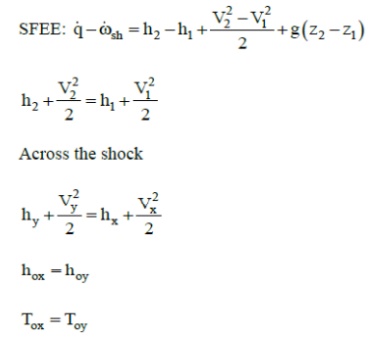
To remains constant across the shock.
(iii)
Momentum
Newton’s second law

Impulse function remains
constant across the shock.
Property relations across the shock.
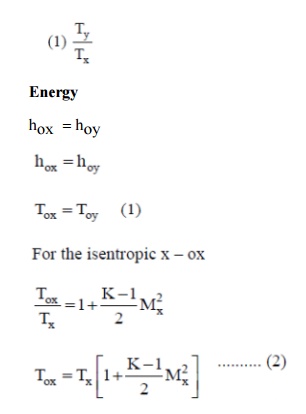
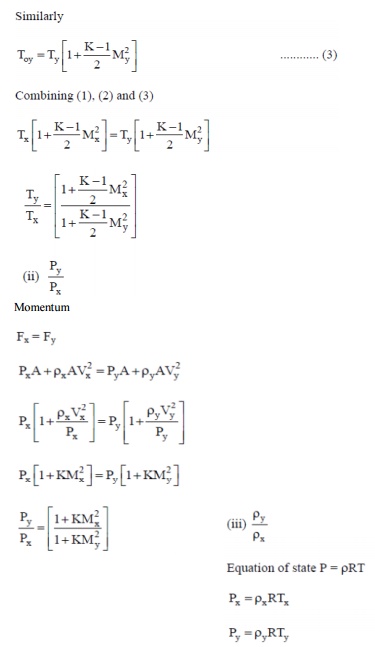

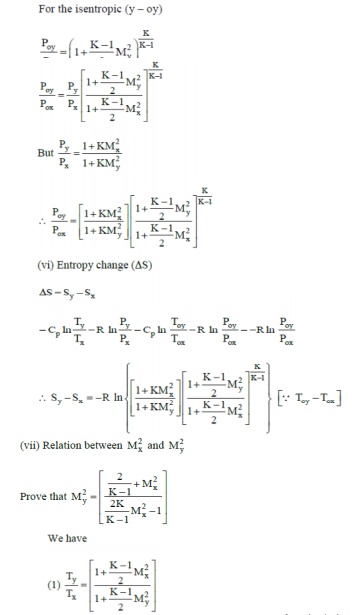

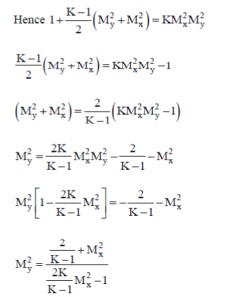
Property relations in terms of incident Mach Number Mx
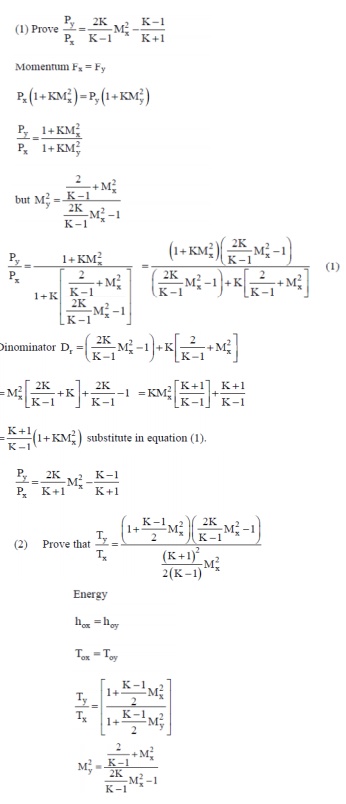
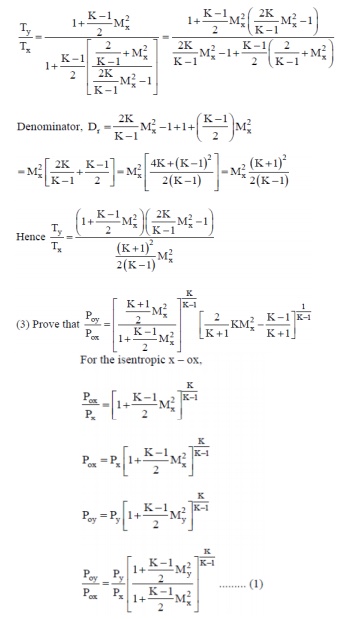
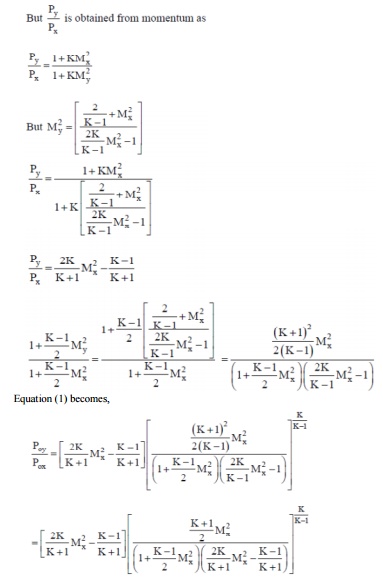
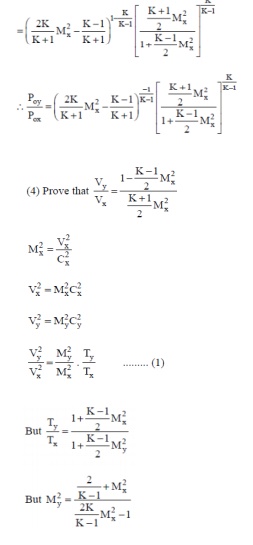
Substituting and simplifying

Substituting (2) in (1), we have
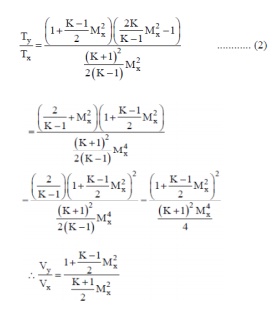
Prandtl-Meyer relationship

Governing relations for a normal shock
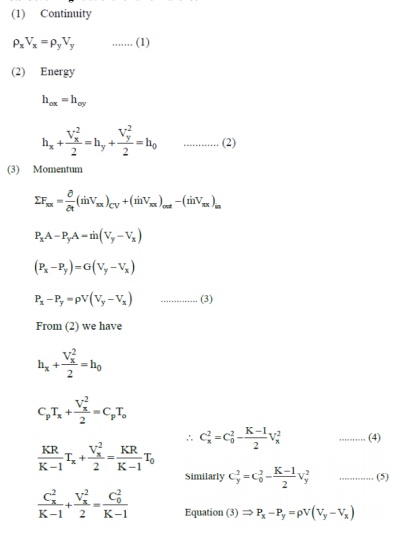
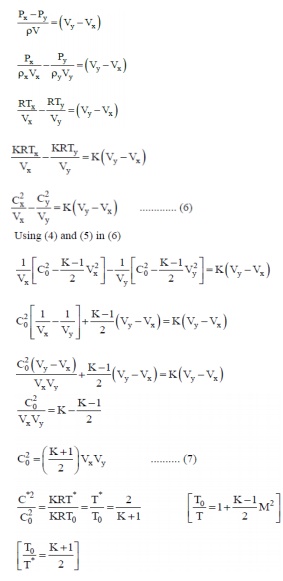
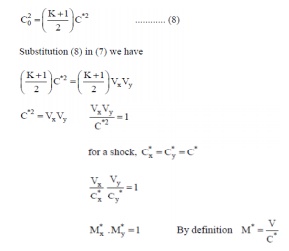
The Rankine – Hugoniot
Equatios
Density Ratio Across the
Shock
We know that density,
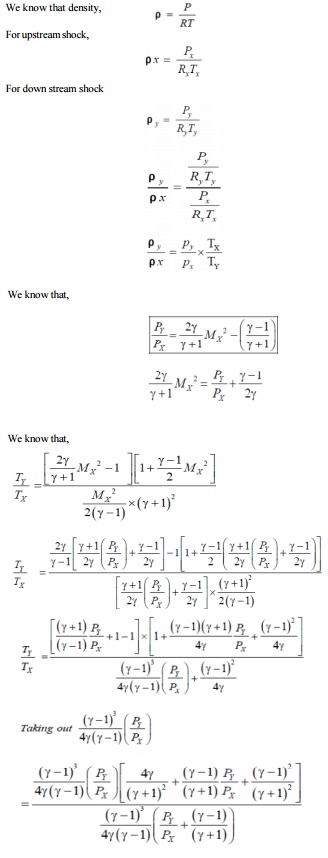
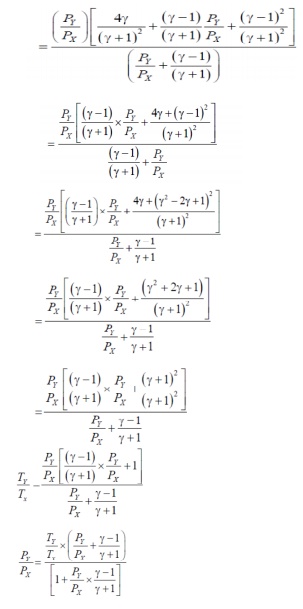

the above eqn.s is knows
Rankine - Hugoniot equations.
Strength of a Shock Wave
It is defined as the ratio of difference in down stream
and upstream shock pressures (py - px) to
upstream shock pressures (px). It is denoted by ξ.

The strength of shock wave may be expressed in another
form using Rankine-Hugoniot equation.

From this equation we came to know strength of shock wave
is directly proportional to;
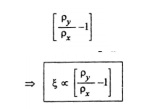
PROBLEMS
1.The
state of a gas (γ=1.3,R =0.469 KJ/KgK.) upstream of normal shock wave is given
by the following data: Mx =2.5, Px =2 bar. Tx =275 K calculate the Mach
number,pressure,temperatureand velocity of a gas down stream of shock: check
the calculated values with those given in the gas tables.Take K =γ.
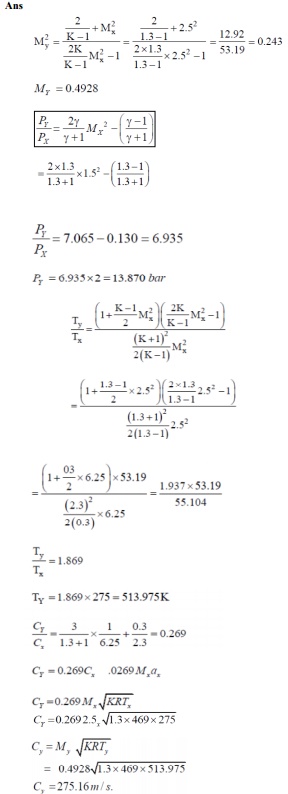
2. An
Aircraft flies at a Mach number of 1.1 at an altitude of 15,000 metres.The
compression in its engine is partially achieved by a normal shock wave standing
at the entry of the diffuser. Determine the following for downstream of the shock.
1. Mach
number
2. Temperature
of the air
3. Pressure
of the air
4. Stagnation
pressure loss across the shock.

3.
Supersonic nozzle is provided with a constant diameter circular duct at its
exit. The duct diameter is same as the nozzle diameter. Nozzle exit cross
ection is three times that of its throat. The entry conditions of the gas
(γ=1.4, R= 287J/KgK) are P0 =10 bar, T0 =600K. Calculate the static pressure,
Mach number and velocity of the gas in duct.
(a)
When the nozzle operates at its design condition. (b) When a normal shock
occurs at its exit. (c) When a normal shock occurs at a section in the
diverging part where the area ratio, A/A* =2.
Given: A2 =3A*
Or
A2/A*=3 γ=1.4
R= 287 J/KgK
P0= 10 bar = 106 Pa T0=
600K
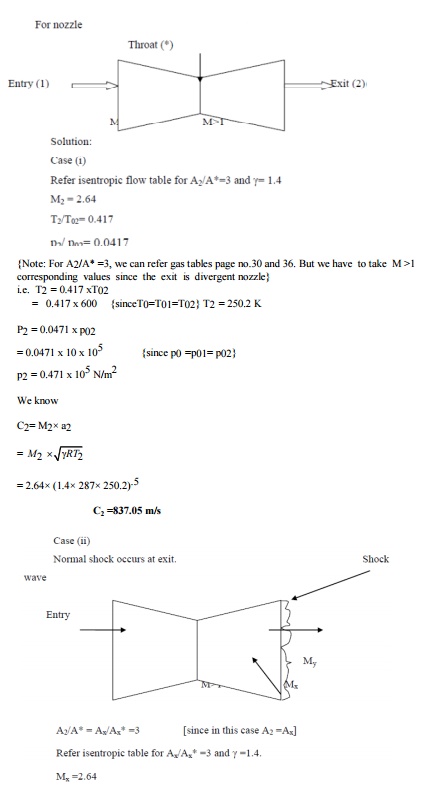
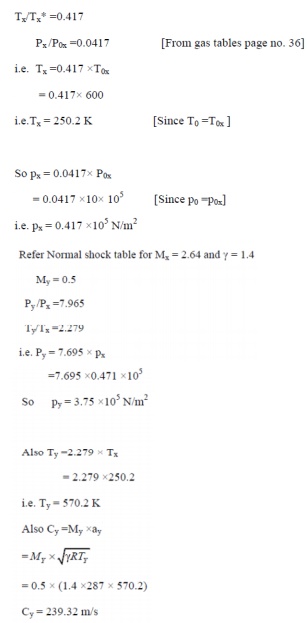
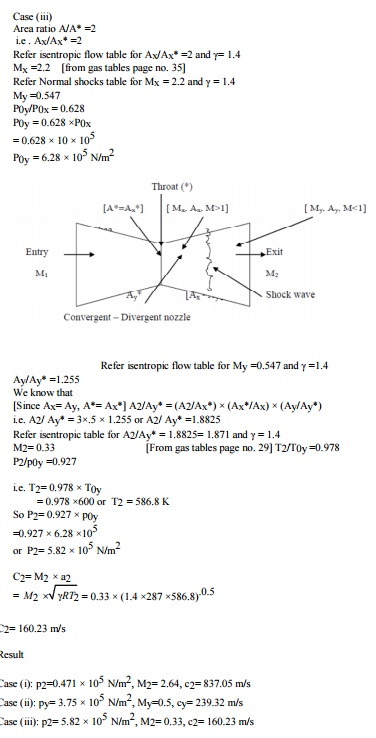
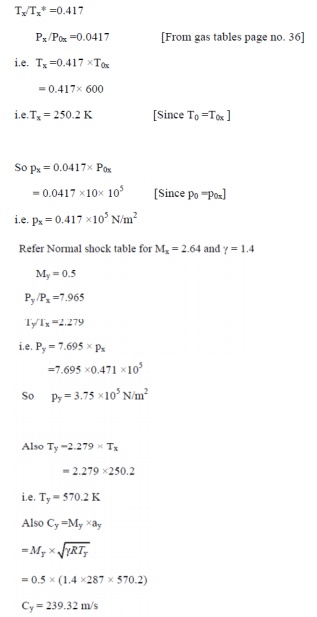
Tutorial Problems:
1) The
state of a gas (γ=1.3,R =0.469 KJ/Kg K) upstream of a
normal shock is given by the following data: Mx =2.5, px= 2bar ,Tx =275K
calculate the Mach number, pressure,temperature and velocity of the gas
downstream of the shock;check the calculated values with those give in the gas
tables.
2) The
ratio of th exit to entry area in a subsonic diffuser is 4.0 .The Mach number
of a jet of air approaching the diffuser at p0=1.013 bar, T =290 K is 2.2
.There is a standing normal shock wave just outside the diffuser entry. The
flow in the diffuser is isentropic . Determine at the exit of the diffuser.a)
Mach number , b) Temperature, and c) Pressure d) What is the stagnation
pressure loss between the initial and final states of the flow ?
3) The
velocity of a normal shock wave moving into stagnant air (p=1.0 bar, t=170C
) is 500 m/s . If the area of cross- section of the duct is constant determine
(a) pressure (b) temperature
(c)
velocity of air (d) stagnation temperature and (e) the mach number imparted
upstream of the wave front.
4)
The following data refers to a supersonic
wind tunnel:
Nozzle
throat area =200cm²,Test section cross- section =337.5cm²,
Working fluid ;air (γ =1.4, Cp =0.287 KJ/Kg K) Determine the
test section Mach number and the diffuser throat area if a normal shock is
located in the test section.
5) A
supersonic diffuser for air (γ =1.4) has an area ratio of
0.416 with an inlet Mach number of 2.4 (design value). Determine the exit Mach
number and the design value of the pressure ratio across the diffuser for
isentropic flow. At an off- design value of the inlet Mach number (2.7) a
normal shock occurs inside the diffuser .Determine the upstream Mach number and
area ratio at the section where the shock occurs, diffuser efficiency and the
pressure ratio across the diffuser. Depict graphically the static pressure
distribution at off design.
Starting from the energy equation for flow through a
normal shock obtain the following relations (or) prandtl –
meyer relation Cx Cy =a* ² M*x M*y =1
Related Topics